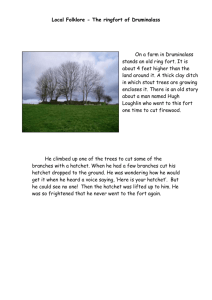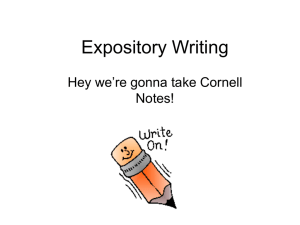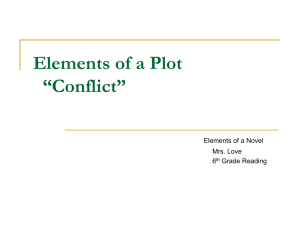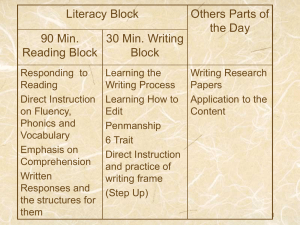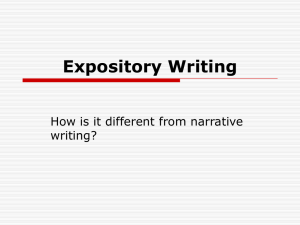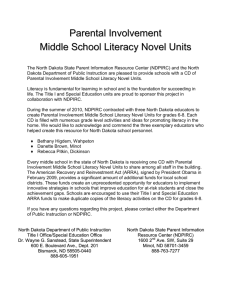Utilizing Extended Response to Enhance
advertisement
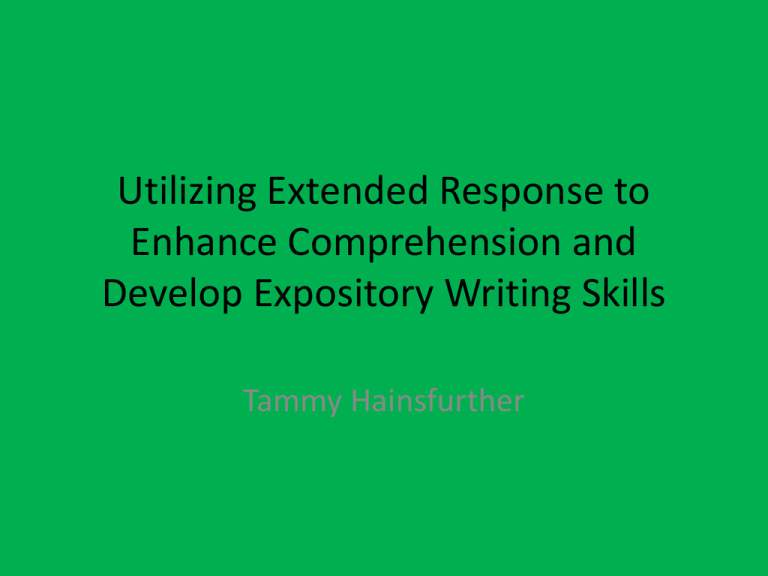
Utilizing Extended Response to Enhance Comprehension and Develop Expository Writing Skills Tammy Hainsfurther What is Extended Response? • Extended Response is part of the Illinois Standards Achievement Test in which students are asked to read a passage and respond in writing to demonstrate an accurate understanding of the text by responding to main ideas stated explicitly or implicitly, and other important information. Readers are asked to support their answers by providing information, examples and details from the text, and making connections. Connections that improve reading comprehension • Connections can be: • Text to self-What do I think about this or what connections can I make with what I already know? • Text to text-This character, setting, plot or theme reminds me of another story I read…… • Text to world-How does the main idea relate to other people, subjects, concepts or events? What is expository writing? Expository writing gives information, explains, defines, or describes. Examples of expository text include: essays speeches journals magazine or newspaper articles directions Why ask students to write an extended response? • “True comprehension goes beyond literal understanding and involves the reader’s interaction with text. If students are to become thoughtful, insightful readers, they must extend their thinking beyond a superficial understanding of the text.” • Harvey & Goudvis, 2000 ISAT Extended Response Reading Rubric Grades 3 and 4 Question: How can I integrate the ISAT (Illinois Standards Achievement Test) Reading Extended Response with my novel teaching to improve student comprehension, extent thinking, and develop expository writing while preparing for the ISAT exam? Sample Novel: Hatchet By Gary Paulsen Motivational Video on Gary Paulsen Lesson Plan • Extended Response will be introduced to the whole group and modeled on the overhead with a transparency of the Baseball Answer Graphic Organizer using student ideas, and then reinforced and practiced in small Literature Circles during the reading of Hatchet. Students will write on dated copies of the baseball graphic organizer and these will be kept in the student writing folder for comparison at later dates. Triple! Homerun! Hatchet Questions • Following Chapter 11 please answer the following question in writing using the Baseball Graphic Organizer. • How does Brian see and hear differently from when he first crashed? Use information from the novel and your own ideas and conclusions to support your answer. Additional Questions • After reading Chapter 12 please respond to the following: • What does Brian mean when he says “Discoveries happened because they need to happen?” Use information from the novel and your own ideas and conclusions to support your answer. • After reading Chapter 16 please respond to the following: • How does Brian react to being attacked and nearly killed at the lake, and then having everything destroyed by a tornado? Use information from the chapter and your own ideas and conclusions to support your answer. • After reading Chapter 18 please respond in writing to the following: • Explain what Brian means when he says that the loss of the hatchet means that he has nothing. Use information from the novel and your own ideas and conclusion to support your answer. Concluding Prompt • Explain how Brian has changed both mentally and physically from when the plane crashed to the end of the novel. Use information from the story and your own ideas and conclusions to support your answer. Assessment • Responses will be assessed on content only • Developmental expository writing does not happen overnight, but rather with practice over time. • Diagnostic assessment will take place as the student begins to write. Has comprehension taken place? Is the student on task, engaged, thinking, and responding in writing? • Formative assessment takes place as the student writes, not just on one occasion, but over time. Is there improvement? Is information from the text used to support the answer? Are connections being made? • Summative assessment will take into consideration progress over time when conferencing with the student and comparing expository writing samples with those completed earlier in the year. Are we where we want to be in November, then January, and finally in February for the ISAT’s in March? Grades State Goals for including Extended Response Questions for Hatchet • 1.4.15 Demonstrate understanding by using graphic organizers to represent passage content • 1.4.17 Determine the answer to a literal or simple inference question regarding the meaning of a passage. • 1.4.19 Identify the main idea of a selection when it is not explicitly stated • 1.4.22 Draw inferences, conclusions, or generalizations about text, and support them with textual evidence and prior knowledge State Goals for including Extended Response Questions for Hatchet • 2.4.03 Identify events important to the development of the plot and subplot • 2.4.06 Compare stories to personal experience, prior knowledge, or other stories • 2.4.08 Determine what characters are like by what they say or do by how the author portrays them • 2.4.09 Determine character motivation Reflection • My goal is to use expository writing during novel reading to enhance comprehension, extend students’ thinking about what they have read, and prepare for the ISAT exam. To teach students to respond in writing to what they have comprehended during reading takes considerable time and effort on the students’ and teacher’s part. Practice needs to start early in the school year. Teachers must communicate what is expected and guide students toward this goal by reading what the student has written and communicating back to the student through written responses and conferences. Expository writing must be practiced on an ongoing basis. My plan is to include three to four extended response, or open ended questions with each novel. Examples have been given for Hatchet. Perhaps one of the most difficult parts is thinking up the questions! The time and effort involved in this project is well worth the reward of developing students who can and do read, write, listen, speak, and think. References • Harvey, S. & Goudvis, A. (2000). Strategies that work: Teaching comprehension to enhance understanding. Portland, ME: Stenhouse
